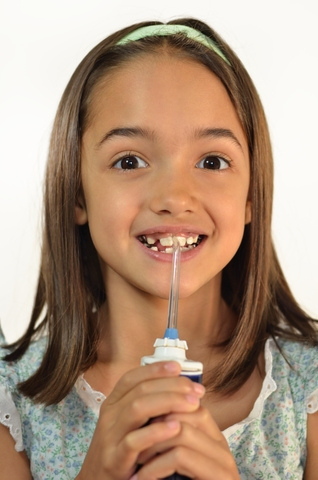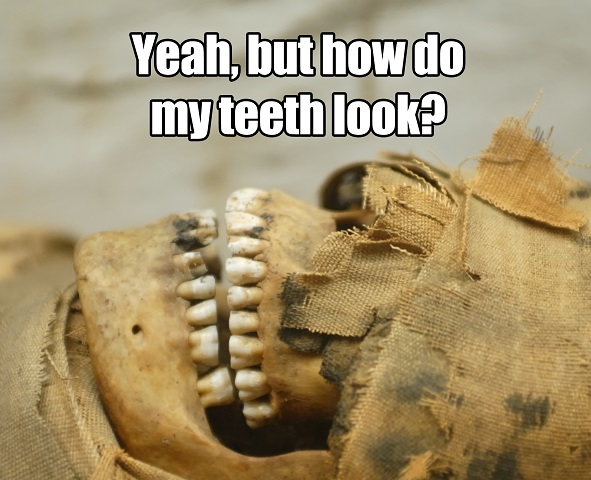April 16th, 2014

Sure, your braces may look clean, but lurking in the crevices of your brackets are billions of bacteria, just waiting to create havoc on your teeth and gums. At Tavarez Orthodontics, we know that, in addition to professional hygiene cleanings, brushing and flossing are the best ways to keep decay-causing bacteria at bay. A cavity, especially if it’s around one of your brackets, can lengthen your time in braces, and we know you don’t want to have your braces one day longer than you have to!
It doesn’t matter when you floss; just do it!
No excuses! Flossing first allows you to brush away dislodged food debris afterward. Brushing first allows you to loosen plaque between the teeth and your braces, making it easier to floss more effectively. Try doing both at the same time! (Just kidding; don’t try that at home.)
The important part of flossing is doing it, and doing it right. That means using a fresh strand of dental floss each day (reused floss is gross), and carefully pulling it back and forth between all of the teeth. Special orthodontic floss is available to help guide the thread between your wires, so there’s really no excuse not to floss!
Think you can fib your way out of flossing? It turns out, we can tell if you’ve been flossing or not, so don’t try to hide it. We won’t be mad, just as long as you promise to start flossing on a daily basis. It’s for your own good, and ours, since looking at plaque-covered braces and teeth every day is kind of gross for us, too.
April 16th, 2014

The idea for Earth Day was the brainchild of Gaylord Nelson, a senator from Wisconsin. He envisioned an Earth Day that would be a kind of environmental teach-in. The first Earth Day celebration took place on April 22, 1970, and a surprising 20 million people participated on that day. Ultimately, it became the largest organized celebration in US history.
Earth Day Over the Years
Over the years, the recognition of the day, and the number of people celebrating it all over the world, turned Earth Day into an international celebration. Because it is celebrated throughout the world, it is not only the largest international environmental observation, but it is also more widely celebrated than any other environmental event in the world. Today, Earth Day is celebrated in 175 countries where over 500 million people participate in celebrations.
The Earth Day Movement
The Earth Day movement is credited with developing the idea that people should “think green”. It encouraged congress to enact laws, including one that resulted in the creation of the Environmental Protection Agency. It also inspired the passage of the Endangered Species Act.
The Five R's and Their Importance
- Reduce – Reduce by avoiding unnecessary purchases. Reduce your use of materials that wind up in landfills. Reduce the use of chemicals around your house. Reduce your use of disposable bags, plates, cups, eating utensils, and batteries.
- Reuse – Instead of using plastic bags for your groceries or purchases, bring your own reusable bags. When you go to buy coffee at Starbucks, take a travel mug so you don't have to get your coffee in a disposable paper cup. Instead of storing food in disposable refrigerator containers, buy containers that can be washed and reused. Don't use regular batteries. Whenever possible, opt for rechargeable batteries that you can reuse.
- Recycle – Most cities offer a recycling program to collect used bottles, cans, and newspapers. Recycling includes collecting recyclable materials that would otherwise be considered waste, sorting and processing recyclables into raw materials such as fibers and manufacturing raw materials into new products.
- Re-buy – Make an effort to purchase things that are made through recycling. When purchasing furniture, look for items that are made from reclaimed wood. When buying paper for kids school work, computer printer paper, holiday cards, or anything else, make a point of purchasing recycled paper products. Instead of buying clothing at full retail price, shop for second hand clothing. You will save a lot of money by doing so!
- Rethink – Rethink the way you do things so that you do them in an eco-conscious way at all times. Instead of driving to work alone, consider taking the bus or going in a carpool. Walk or ride your bike when you're only going a short distance. Plan your shopping trips and errand runs so that you can do everything on one day, and do it in a way where you can save time and gas.
Other ways to "think green" include growing your own food, composting yard waste and food scraps, or by participating in local recycling programs. Join a group like Freecycle so you can share your unneeded and unwanted possessions with people who can use them. Likewise, you'll be able to get things you need or want for free.
Earth Day teaches people that the planet belongs to everyone, so everyone is equally responsible for protecting it. Although Earth Day is an environmental celebration, our team at Tavarez Orthodontics wants to remind you that you don't have to wait until then to make changes that will allow you and your family to live a greener life.
Happy Earth Day from the team at Tavarez Orthodontics.
April 9th, 2014

Water picks, sometimes called “oral irrigators,” make an excellent addition to your regular home care regimen of brushing and flossing. Especially helpful to those who suffer from periodontal disease and those patients of ours undergoing orthodontic treatment with full-bracketed braces, water picks use powerful tiny bursts of water to dislodge food scraps, bacteria, and other debris nestled in the crevices of your mouth. Children undergoing orthodontic treatment may find using a water pick is beneficial if their toothbrush bristles tend to get caught on their wires or brackets.
When you use a water pick, you’re not only dislodging any particles or debris and bacteria you might have missed when brushing, you are also gently massaging the gums, which helps promote blood flow in the gums and keeps them healthy. While water picks are an excellent addition to your daily fight against gingivitis and other periodontal diseases, they are incapable of fully removing plaque, which is why Dr. Kathleen Tavarez and our team at Tavarez Orthodontics want to remind you to keep brushing and flossing every day.
If you have sensitive teeth or gums and find it uncomfortable to floss daily, water picks are a good alternative to reduce discomfort while effectively cleaning between teeth. Diabetics sometimes prefer water picks to flossing because they don't cause bleeding of the gums, which can be a problem with floss. If you have a permanent bridge, crowns, or other dental restoration, you may find that a water pick helps you keep the area around the restorations clean.
So how do you choose the right water pick?
Water picks are available for home or portable use. The home versions tend to be larger and use standard electrical outlets, while portable models use batteries. Aside from the size difference, they work in the same manner, both using pulsating water streams. A more crucial difference between water picks is the ability to adjust the pressure. Most home models will let you choose from several pressure settings, depending on how sensitive your teeth and gums are. Most portable models have only one pressure setting. If you want to use mouthwash or a dental rinse in your water pick, check the label first; some models suggest using water only.
Please give us a call at our Menlo Park or San Carlos, CA office if you have any questions about water picks, or ask Dr. Kathleen Tavarez during your next visit!
April 8th, 2014
Orthodontics has been around for thousands of years!

It's hard to believe, but braces have been around since ancient times. While our ancestors may not have used braces that look as sleek as ours today, you can bet that somewhere along the line, some poor Grecian kid got called “brace face.” How do you say that in Greek?
Historians think that the earliest braces were made of base metals and catgut, a type of natural fiber, dating back to around 2000 B.C. Archaeologists have discovered mummified remains in various Italian locations that have metal bands wrapped around the teeth. A Roman tomb was also discovered in which the teeth were bound with gold wire, including documentation on the wire’s use as a dental device. Sounds comfortable, doesn’t it?
The first braces were developed by Pierre Fauchard in 1728. Fauchard's braces consisted of a flat strip of metal which was connected to teeth by pieces of thread. Imagine having to floss around that!
More modern orthodontic brackets were invented by Edward Angle in 1915. The brackets consisted of little hooks of metal, which were attached to bands which went around your teeth. In 1928, he modified the design, producing the edgewise bracket, and braces as we know them today were born!











 Website Powered by Sesame 24-7™
Website Powered by Sesame 24-7™